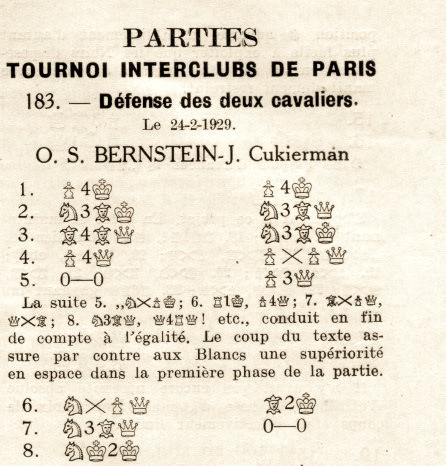
Edward Winter
A miscellany of Chess Notes items on some of the ways of recording chess moves which have been seen over the years.
***
‘Chess, being a game of pure intelligence and powerful imagination, has ever remained the beloved of intelligent persons. So they devised a system of enjoying the game even if they are absent. That system is writing notations for the moves.’
Source: page 41 of a 191-page hardback published in India in 2001: Chess (Basics, Laws and Terms) by B.K. Chaturvedi.
***
One’s only complaint about the algebraic notation is the necessity of using (faute de mieux) the ugly abbreviation N for knight. It has been remarked, however, that N may well stand for Nag or even ’Norse ...
(40)
In a generous review of Chess Notes in The Gamer a writer reported, however, that C.N. 40 had occasioned him to wince. Our ‘faute de mieux’ apparently caused the trouble, why we are not sure. From George Jelliss:
‘There is no necessity of using N for Knight. Problemists have for donkey’s years used S (from the German “Springer”). Among fairy chess enthusiasts N is reserved for Nightrider. It is a great pity that a rift has developed between gamers and puzzlers over this abbreviation for knight.’
Donkey’s years takes us back to the Nag and ’Norse ... Whether to use S for knight in chess play is a personal choice; on the whole, we find it a little affected (hence N faute de mieux). But is it logical anyway that the poor knight should be forced to change its initial, and not the king? After all, knights generally move far more often than kings, quite apart from the fact that there are twice as many.
(309)
C.N. 331 suggested that Modern Chess Openings was favoured by ‘DNOs’ (‘Descriptive Notation Ostriches’). C.D. Robinson (Toronto (Canada) writes:
‘I am a “DNO”. There must be something wrong with a notation that forces one player to read the alphabet from right to left and to count backwards.’
Without – for the moment – re-entering a discussion on the relative merits of the descriptive and algebraic notations, we would like to clarify the definition of ‘DNO’. It is not simply someone who prefers the descriptive. (Personally we confess to being fond of the descriptive notation – for mainly sentimental reasons: all the great classics of Alekhine, Tarrasch, Nimzowitsch, Capablanca, etc. use descriptive in their English editions. It had a most honourable tradition – until N for Knight came in ...).
The point made in C.N. 331 was that BCO is a far better book than MCO in all respects. The ‘DNO’ is someone – and alas there are many such people – who will actually buy an inferior book simply because it uses the ‘good old notation’. He’ll probably boast about it, too. Nobody can really begin to call himself a chessplayer if he is not completely ‘bilingual’, whatever personal preference he may have.
As regards our final question in C.N. 309, Tony Gillam (Nottingham, England) reminds us that the king is K in many languages, whereas the knight’s initial varies a great deal.
(388)
The October 1985 BCM (pages 454-455) comments that ‘ambiguity is endemic’ to the descriptive notation. Our recent reading fully confirms this. For example the game Bird v Mason New York, 1876 is given on pages 85-86 of The Book of Chess Lists, White’s 36th move being recorded as ‘ON-K5’. In that position Bird had knights on c6 and g6, and it was the former that he moved. However, any reader who had carefully marked the queen’s-side pieces before playing over the game (as the old books used to recommend) will see that the QKt was the one on g6. Worse, on page 172 there is a position (i.e. the earlier moves are not given) in which White played ‘95 QN-Q5!’ One has to assume that this means the knight at c7, and not the one at e3.
Placing black knights at c6 and c3 and white pawns at e4 and e5 shows another problem in the descriptive. A capture would be recorded in algebraic, or standard, notation as Nxe5 or Nxe4, but in descriptive KtxP, KtxKP, Kt(B3)xP, Kt(B6)xP, KtxP(K4) and KtxP(K5) are all ambiguous, the last four because it has been the practice to allow such identification squares to be counted from either White or Black’s side. On the other hand, references to QKtxP or KKtxP might leave the reader lost if the two knights had been active all over the board. Thus the only solution is to give KtxP(e5) or KtxP(e4).
The same BCM (page 437) also makes the point about economy in the use of symbols/letters, and here it may be thought that some users of the descriptive are their own worst enemies. From page 1 of Chernev’s The 1,000 Best Short Games of Chess: ‘Wherever I thought it would help, I have elaborated the pure description of moves. For example, 9 QxPch might tend to make you look wildly around to see which pawn the queen does capture with check. It is easier to find the pawn when the move reads 9 QxP(B6)ch or 9 QxBPch.’ This hardly flatters the reader. CHESS also tends to over-describe moves.
Practically speaking, the algebraic wins hands down yet, as hinted in C.N. 388, we feel quite nostalgic about the good old descriptive, warts and all, and even now still find it much superior aesthetically.
(1062)
Gordon Pollard (Wallingford, England) speaks up for the descriptive:
‘I am pleased to see that you retain some affection for descriptive notation. So do I. Its ambiguity lies I think not in any basic defect of the system but in the carelessness or stupidity of the player using it. The identification of squares ought not to present difficulty because each player views the position from his own side of the board, and it would be illogical to identify a square by suddenly counting from the opposite side.
I sometimes wonder whether algebraic, excellent as it may be for problems and studies, is really suitable for recording games. The player of the black pieces sooner or later forgets that he has to record from White’s point of view and consequently counts ranks wrongly. I find this often in game-scores sent to me, and I have before me now one in which Black plays Q-B3; he records it as Qf3 but it should of course be Qf6.
As pro-algebraic players allege that one of its advantages is its brevity, I have never understood why, for example, Bxc6 is written instead of BxN (and anyhow it is the piece, not the square, which is captured); and if a bishop now recaptures we have two dissimilar operations – capture of a knight and capture of a bishop – both recorded as Bxc6. That is hardly a point in favour of algebraic.
I have never used the dash when writing descriptive notation, as it seems unnecessary. I find QKN5 as easy to read as Q-KN5 for example; and so apparently did Walker (Oxford Companion, page 227). No dashes have ever appeared in my Herald column, and no reader has ever written to complain.
Not all chessplayers are good calligraphists, and the standard of legibility of game-scores is apt to deteriorate progressively as the struggle intensifies and time runs short. I have always been able to unravel scores in descriptive notation however badly written, but I have had scores in algebraic notation given to me when all my efforts have failed to establish how the game proceeded – some of the squiggles could represent any move.
I doubt whether descriptive notation is dying quite as quickly as some authorities would have us believe. When taking a peek at players’ score-sheets at matches, county and club, I usually find the proportion of algebraic and descriptive to be about 50-50. Few, if any, chess columns in British newspapers or journals that I have seen use anything other than the descriptive.
Dare I hope that when mentioning notations in Chess Notes you will make a plea for the abolition of the detestable (in my view) practice of omitting all reference to capture and check? I believe the practice started in Informator. It saves a little space, but I can vouch for the fact that it very much hinders a harassed chess columnist who wants to play through a game quickly to see whether it will provide suitable entertainment for his readers.
One very great advantage of descriptive is that it is far easier on the eyes. I find when reading algebraic that I need frequently to have recourse to a magnifying glass to distinguish between “c” and “e”, or “h” and “b” when either makes sense.
I agree with your remark in C.N. 388 that it behoves us to be completely “bilingual”. Although I am prepared to argue the case for either notation, I am inclined to think that algebraic has the greater number of warts.’
(1090)
Tony Gillam takes up points made by our correspondent in C.N. 1090:
‘I agree with Gordon Pollard that the practice of leaving out capture signs and checks is detestable. However, I can explain why Informator have adopted the practice. They argue that including capture and check signs would clutter up the text and make it very hard to follow. Because they typeset with large figurines and mathematical signs their argument has some validity. When I decided on the format for The Chess Player I opted for smaller figurines and mathematical signs which enabled me to get round the problem. Also, because I used a bold typeface for the moves played, I reduced the number of brackets needed, which partly offset the increase in signs from indicating captures and checks. I was aware when making my decision that most contributions would come in Informator format, which would mean increased work. It was also inevitable that some capture and check signs would be accidentally missed out, thus increasing the number of errors ...
I also agree that one advantage of the descriptive over the algebraic (probably the only advantage) is that when handwritten it is likely to be more legible. Mr Pollard turns logic on its head when he argues that descriptive is superior because it is “illogical to identify a square by suddenly counting from the opposite side”. This is exactly what you have to do in the descriptive, whether you are White or Black. In the algebraic you always count from your side when White and from the other side when Black. Many boards have letters and numbers to help. The problem over whether Q-B3 is Qf3 or Qf6 (or Qc3 or Qc6) points out the ambiguity inherent in the descriptive. Also, it is largely a problem for those of us who learned descriptive first. Those players who know only the algebraic don’t have this problem.
The following paragraph is illogical. One of the advantages of the algebraic is its brevity (what is this “allege” business?). This does not mean that it seeks to be more brief or that it should be altered to become as brief as possible. Bxc6 is consistent with the way in which the rest of the moves are recorded. BxN could be anything, but Bxc6 has only a limited range of possibilities. The algebraic is easier to learn, easier to visualize, more precise and, incidentally, more concise.’
Mr Gillam’s reference to ‘those players who know only the algebraic’ is a reminder that increasing numbers of potential students will be cut off (or, rather, will cut themselves off) from the classic old books in descriptive notation. An enterprising publisher will perhaps obtain the rights to produce algebraic editions, seizing the opportunity to make textual corrections as well.
In the days when the descriptive dominated, were any prominent writers ‘letter perfect’ in their use of it? We have done a brief spot-check of two books by experienced authors and players, taking one game at random from each:
Capablanca’s Hundred Best Games of Chess by H. Golombek (Capablanca v Colle, Barcelona, 1929): Two identical moves (in algebraic 12 Rcl Rc8) are recorded inconsistently as 12 QR-B1 R-QB1. In a note to move 22 there is 29...PxP, although it could be either the c or e pawn that is captured. That was all we found, although incidental mention may be made of an error in the final note: Black is mated in three, not four, moves.
Alekhine’s Best Games of Chess 1938-45 by C.H. O’D. Alexander fell open at ‘Dr Florian v Alekhine, Prague 1942’. The game gets off to a bad start – the date should be 1943 – from which it never recovers. In the note to White’s fourth move 4 B-KB4 ought to read 4 B-QB4 and 5...B-R2 is impossible (presumably it should be 5...B-K2). Black’s fifth move in the game is recorded as 5...P-B3 although both BPs can advance. The note to White’s 15th move gives 15 PxP, although two such captures are possible. In a note to White’s 21st move we are given 23 K-B1 instead of 23 K-Kt1. Black’s 21st in the actual game should be ...KtPxB and not ...KtPxKt as stated. Black’s 32nd and 33rd moves are recorded as ...R(1)xQ and QR-B5, which mixes two different systems of distinguishing between pieces. In a note to White’s 36th move, RxQP could simply read RxP since no other pawn can be taken. Similarly, White’s 43rd move in the game should be KtxP and not KtxP(B7).
(1345)
From P.C. Wood (Hastings, England):
‘The figurine algebraic notation is a clutter and very hard to follow. Why is it easier to read through games in Russian, Estonian and in fact almost every country’s books and magazines, rather than it is in the BCM?’
Why, when English is fast becoming the world language, is it England which is doing away with B, N, R, Q and K, and putting little baby pictures in their place? Pergamon books (except for their opening works) use “normal” algebraic and their notation is exceptionally clear. Similarly books published by George Allen & Unwin.’
The question of notation always gives rise to strongly expressed views, although personally we are happy with almost anything as long as it is accurate. We do not find the BCM’s notation a clutter; one rarely comes across a wrong or ambiguous move nowadays, which wasn’t the case with the same magazine’s descriptive notation 50 or 60 years ago.
(1448)
A very rare form of notation is what might be termed the ‘pure figurine’, i.e. all symbols and no letters. The illustrative extract below comes from a game annotated by Alekhine on pages 339-341 of the August 1929 issue of L’Echiquier:

(3724)
For the full game, see C.N. 8766.
On page 11 of the October 1947 issue of CHESS Grace Alekhine wrote, from Dieppe, about chess notation:
‘I sincerely hope Mr Wood will not continue with his combination notation as I find it extremely unpleasant. I am thoroughly familiar with the algebraic notation and enjoy games in French, Spanish, German or Czech so it is not on that account that I object to his innovation. If he continues with it, I shall not renew my subscription again.’
Below is an example (from page 337 of the August 1947 CHESS) of the notation occasionally used at that time:
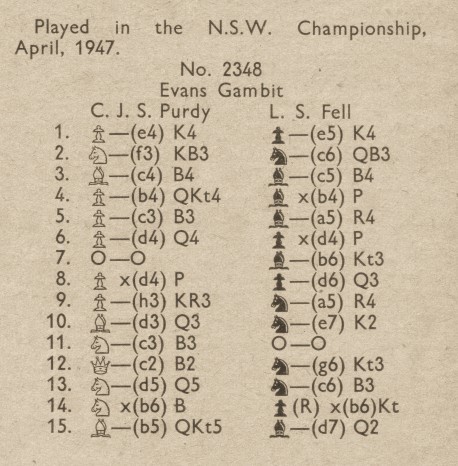
(3747)
An early occurrence of the figurine notation in an English-language publication:
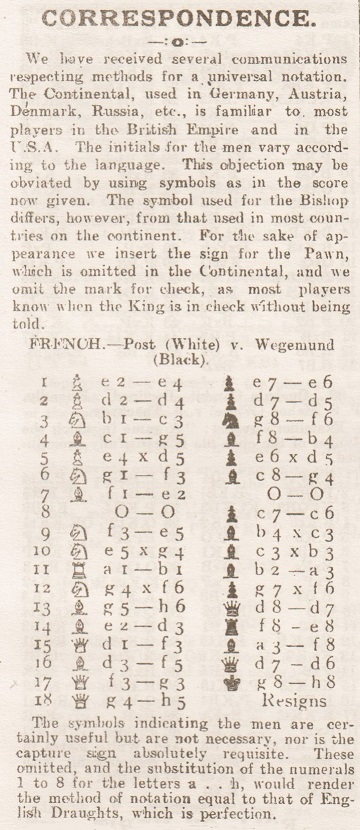
Source: page 551 of the March 1912 Chess Amateur.
The Post v Wegemund game, presented with obvious notational errors at moves 10 and 17, was played in the 1908 Berlin championship and had been published on, for instance, page 137 of Deutsches Wochenschach, 18 April 1909.
(11793)
In the item on Edward Lasker v Moll (C.N. 4239) the former’s use of the descriptive notation was converted to the algebraic. It is, though, worth recalling that, as mentioned on page 154 of A Chess Omnibus, Edward Lasker used the algebraic notation, controversially, in Chess and Checkers The Way to Mastership (New York, 1918).
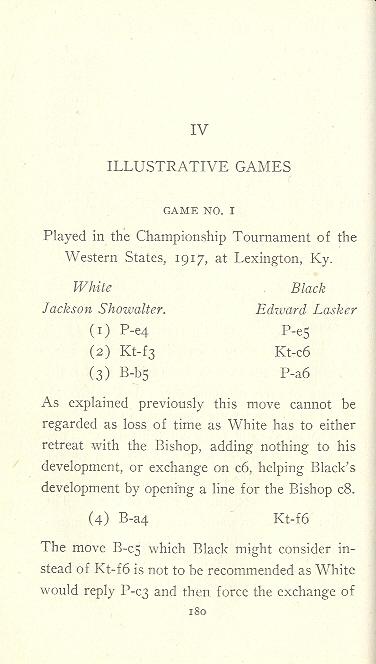
(4240)
Chess in 1924 pointed out that F.P. Betts of London, Ontario had a letter published on page 204 of the November 1924 American Chess Bulletin in which he denounced a book by Edward Lasker (unnamed, but presumably Chess and Checkers The Way to Mastership) for using the ‘extraordinary’ algebraic notation. ‘This mania for improving the established chess notation by freak innovations seems to entirely overlook the fact that there is an immense volume of chess literature centuries old in which the old and accepted notation is enshrined, the value of which would be greatly impaired if this novel jargon should become the vogue.’
A brief passage from the FIDE Congress report on pages 271-272 of the September 1948 CHESS concerns a less substantial matter on which we would nonetheless also welcome particulars:
‘From Brazil came the suggestion of a new improved chess notation; there was one of the few real laughs of the Assembly when Dr Voellmy of Switzerland and C. Kottnauer of Czechoslovakia (world famous as writer and player respectively) who had been deputed to study it confessed that after two days’ examination of the system they were still far from comprehending it.’
(3822)
C.N. 4573 quoted the following advice:
‘Generally keep the L so that it may not be pinned by an M or an N, or be attacked when an O checks.’
It appeared on page 55 of A Complete Guide to the Game of Chess by H.F.L. Meyer (London, 1882), which we described in C.N. 2755 (see pages 59-60 of A Chess Omnibus) as ‘one of the few nineteenth-century chess books in English to use the algebraic notation’.
With leaden ingenuity Meyer explained (on pages 12-15 of his book) that the letters A to H were used for the files on the board and the letters K to P for the units:
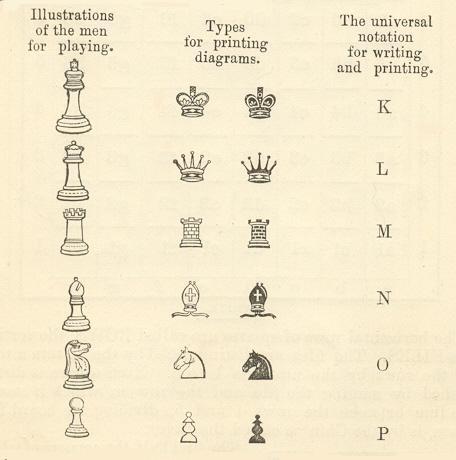
As names Meyer then offered King, Lady Queen, Monument, Neighbor, Over-leaper and Pawn or, as an unnamed American writer had proposed, Keeper, Lord, Master or Minister (also Mammoth), Nobleman, Overseer and Peasant. Meyer optimistically termed the system ‘the universal notation’.
(4589)
Regarding the book by Meyer, see too C.N. 5022.
Michael Clapham (Ipswich, England) points out that The History of Chess by R. Lambe (London, 1764) is relevant to the discussion of old works in English which adopted the algebraic notation (see C.N. 4589):
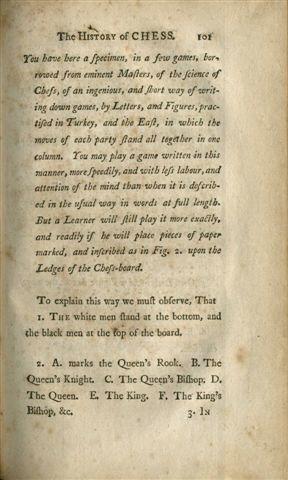
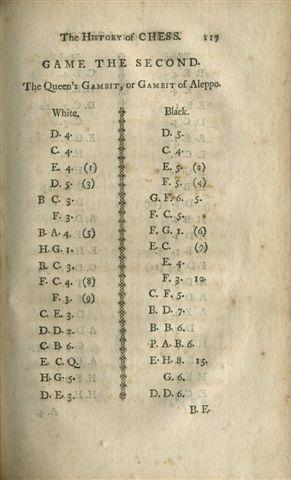
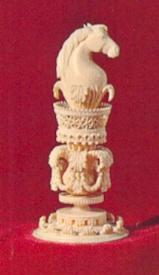
N for knight has become such natural usage in English-language chess writing that its long road to acceptance is easily overlooked.
Even in the nineteenth century occasional attempts were made to avoid Kt in notation. From page 4 of the inaugural issue of the American Chess Review, July 1886:
‘In this magazine the letter S will stand for knight. Our reasons for using it are: First, when Kt is used, should the t be broken off or damaged, the K would remain, and after the student had vainly spent half an hour searching for the move, he would jump up and claw the air and yell for gore. The S knocks the left eye out of any possibility of the introduction of any new gore-shedding process. Second, S is quicker to write. Third, saves time in composition, as one type can be set in less time than two.
We think the use of Kt should be discontinued altogether and S or some other man substituted.’
Four years later came what is the earliest proposal of N that we recall, by William D. Wight of Pontypridd, Wales on page 418 of the October 1890 BCM. At that time the magazine’s notation was (to quote an opening on the same page) 1 P to K4 P to K4 2 B to B4 Kt to KB3 3 Kt to KB3 Kt tks P, and Wight wrote:
‘... as you are open to suggestions, will you permit me to make the following: firstly, that you abandon the use of to and tks for – and x, which are in use in most books; and secondly, that N be used instead of the clumsy Kt for knight.
The suggestion that H be used for knight has been made, but it has the objection of altering the name of the piece to that of horse. The same objection does not apply to N, which is phonetically correct, and being very distinct from any of the other letters in use, its meaning cannot be mistaken.’
Wight did not mention the possibility of employing S (as in the German word for knight, Springer), but occasionally that letter was used by English-language magazines other than the short-lived American Chess Review. In 1914, for instance, the Chess Amateur had Kt in its game-scores but S (and the algebraic notation) in some parts of its solutions. That tranquil co-existence became a war casualty, for on page 122 of the January 1915 issue W. Moffat wrote:
‘In order to clear our pages of every vestige of the German Notation we shall in future use N for Kt, and for the names of the squares use numbers as in the Numerical Notation [e.g. 51 for e1 and 38 for c8].’
An editorial on page 125 of the February 1915 Chess Amateur flayed the algebraic notation (‘the German method, which for stupidity and clumsiness would be difficult to beat’) and reiterated, ‘In our solutions page, for brevity we intend to use N for Kt, and for legibility numbers for the names of the squares instead of a mixture of small letters and figures’. Overleaf, P.H. Williams commented:
‘I hail with delight your decision to use N for knight instead of the illogical S. The former is phonetic and reasonable, nor would the late Sir Isaac Pitman detect a weakness in spelling in those who used it. Any attempt, however, to refer to knight and pawns as “N and chickens” should be discouraged and drastically censored.
But the numerical notation described on page 122 does not appeal to me, nor do I see why the German system should be expunged, except on purely patriotic grounds ...’
On pages 201-202 of the April 1915 issue Fred Brock contributed from Gosport a lengthy letter under the title ‘N Stands for Knight’. He noted that at least some chessplayers ...
‘... are quite willing that N should stand for knight; though where the justification of employing this particular letter comes in, I am quite unable to perceive. We do not spell phonetically; and I, for one, hope we never shall. N, therefore, is not, and, I hope, never will be symbolic of the word knight. We might just as well use X, Y or Z, as the letter in question. Kt, on the other hand, is an eminently descriptive abbreviation of the word, and is known and used by chessplayers in all parts of the world.’
Brock descanted on the subject for over 50 lines more, discussing other possible letters (H for horseman, or C for cavalier, captain or charger) before concluding that Kt should be retained.
A later advocate of N for knight was C.J.S Purdy, in a letter on page 326 of the August 1934 BCM. After announcing that he was ‘abandoning the international notation scheme’ he remarked:
‘What I would like to see, however, is the general use of N for knight. All the columns in Australia use it now, except Gundersen’s, and the ACR will soon follow. I am going to circularize all English and American columns and magazines, but of course the BCM sets the standard.
N is laid down as absolutely alternative by the BCF. The aesthetic objection is purely superficial, for the letters are symbols, not primarily abbreviations (when they would require points after them), so that the first significant letter in knight is the most logical possible to use. I consider it more logical than S, which is not sanctioned officially ...’
The Australasian Chess Review thus switched from Kt to N in the mid-1930s, and Chess Review did so about a decade later. CHESS changed in the 1950s, and the BCM in the 1970s.
During the Second World War, however, the BCM discussed notation once more. In an editorial on pages 209-210 of the August 1941 issue J. du Mont wrote:
‘Exception has been taken to the similarity between K and Kt and the possibility of misunderstandings. It is no worse in principle, and certainly not in practice, than the letters e and c in the Continental notation, especially in small print or in newspapers. However, many people use S instead of Kt, which is reasonable because the German Springer would be descriptive up to a point to the British eye. Others use the letter N, which is ugly and pointless. N stands for nothing at all in chess. (Perhaps a n’orse?).’
In the September 1941 BCM L.C. Birch was given much space (on pages 232-235) to discuss ‘Algebraic v Descriptive Notation’, and once again the knight issue cropped up:
‘I agree with the Editor that N for knight is a vulgar pun, and S is a good alternative. However, an abbreviation for the German Springer is not likely to be accepted today. Why not C for cavalier, bringing our nomenclature in line with French (cavalier), Italian (caval[l]o) and Spanish (caballo)?’
In the ensuing ‘Editor’s note’ (pages 235-236) du Mont left aside the fact that some writers used C for the rook (castle) and commented that Birch’s suggestion was ‘worth considering’. He then added:
‘In an interesting letter received from Mr O.E. Fer, Chester, he wittily suggests that N could, after all, stand for “nag”.’
(4503)
See our feature article on C.J.S. Purdy for more information on this publication, Chess Logic by B. Koppin:
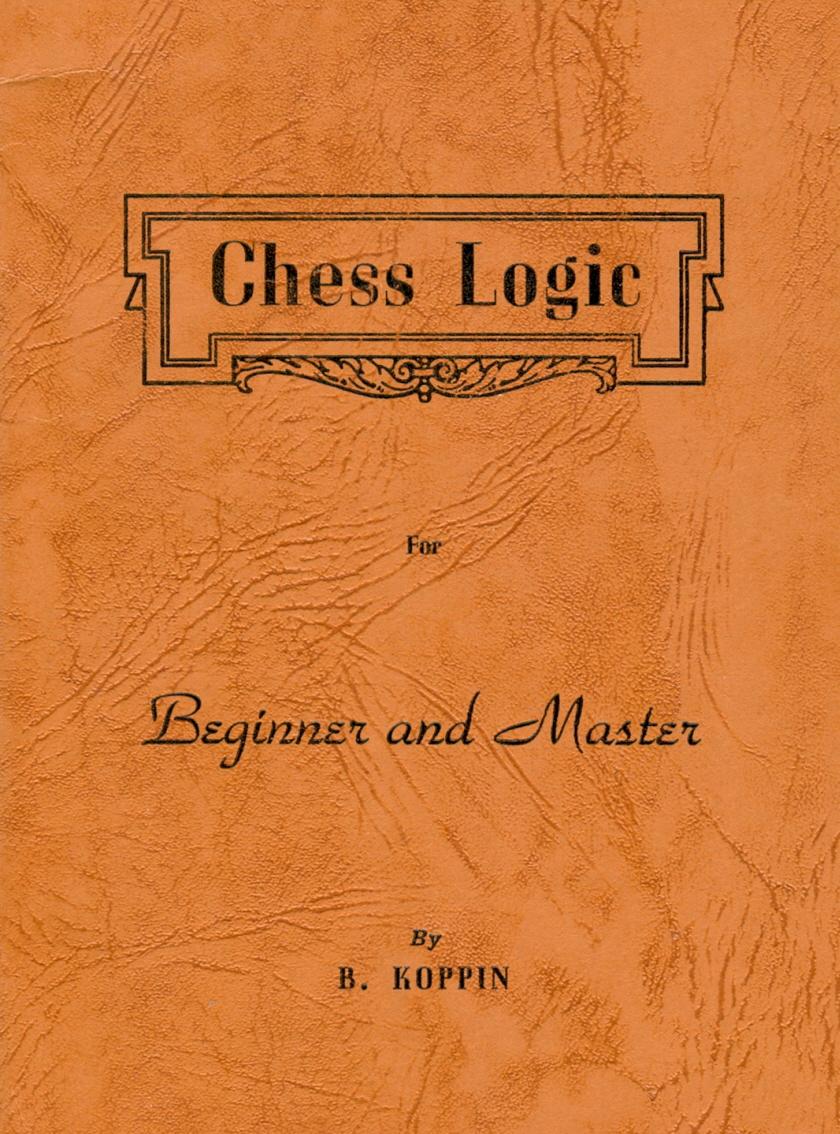
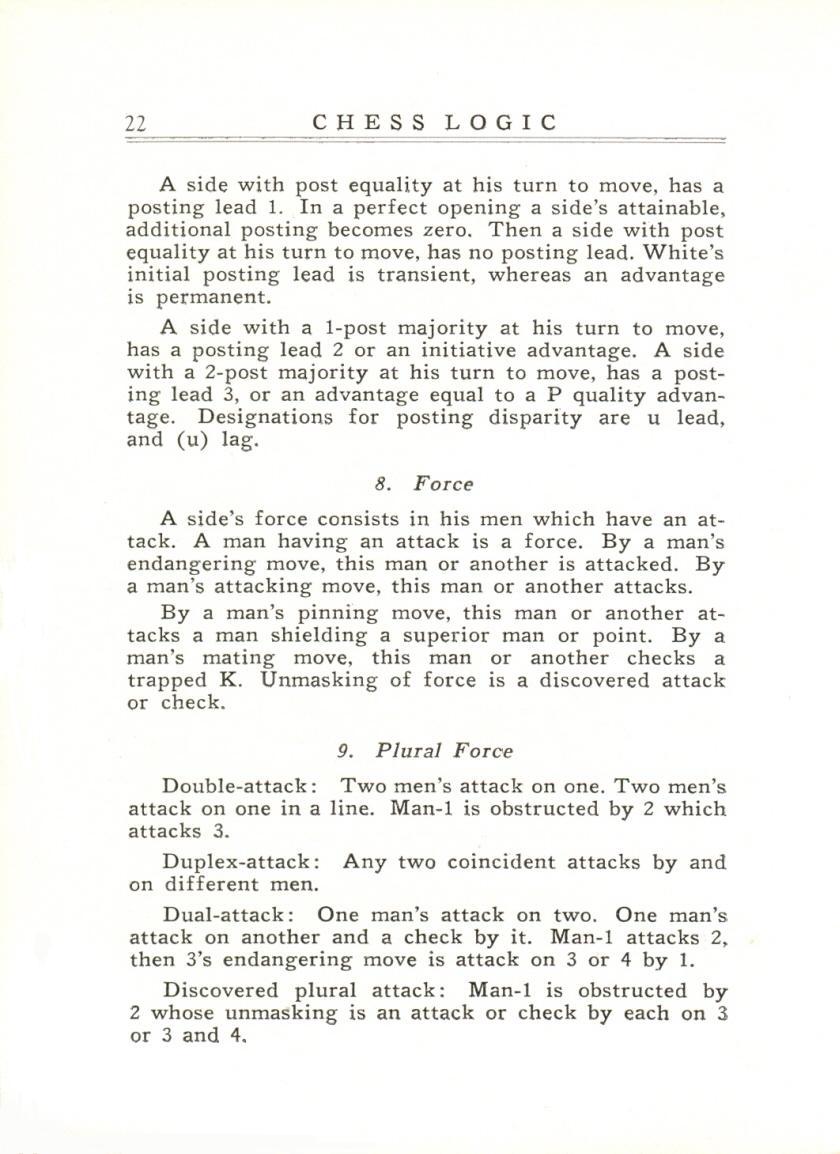
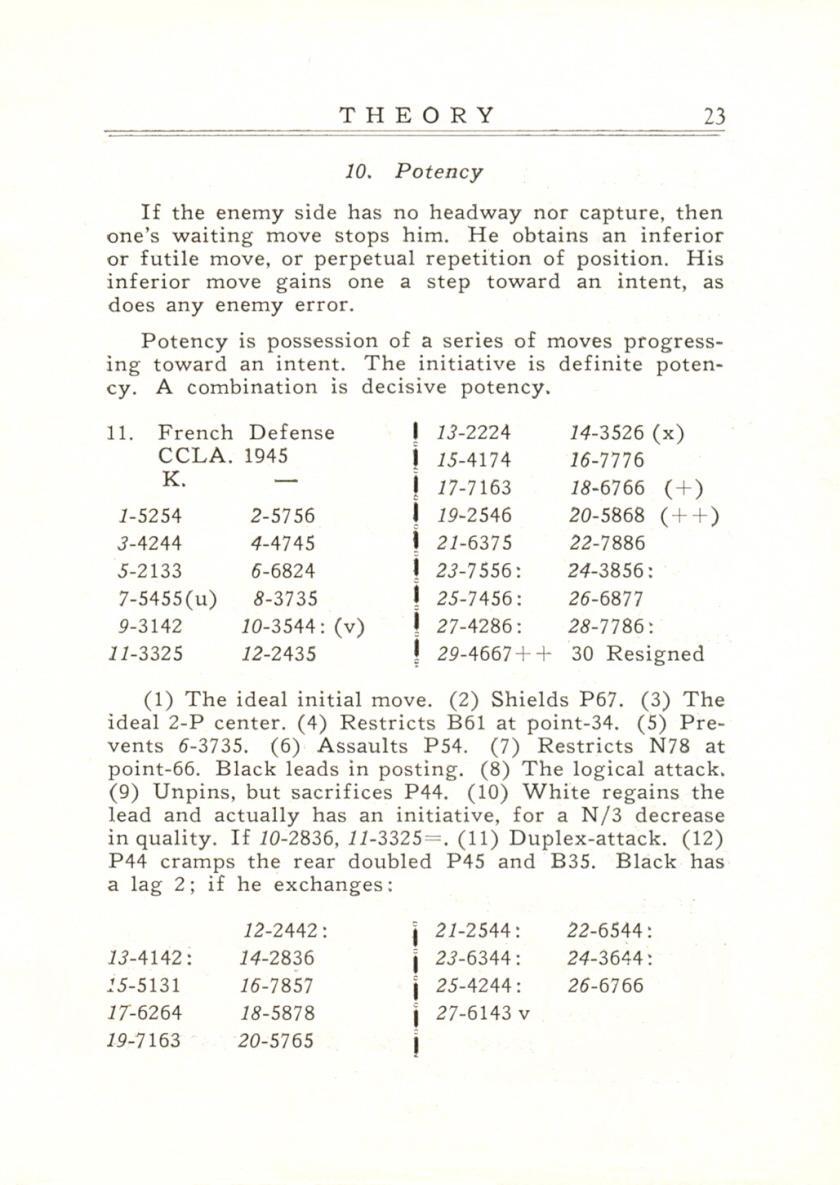
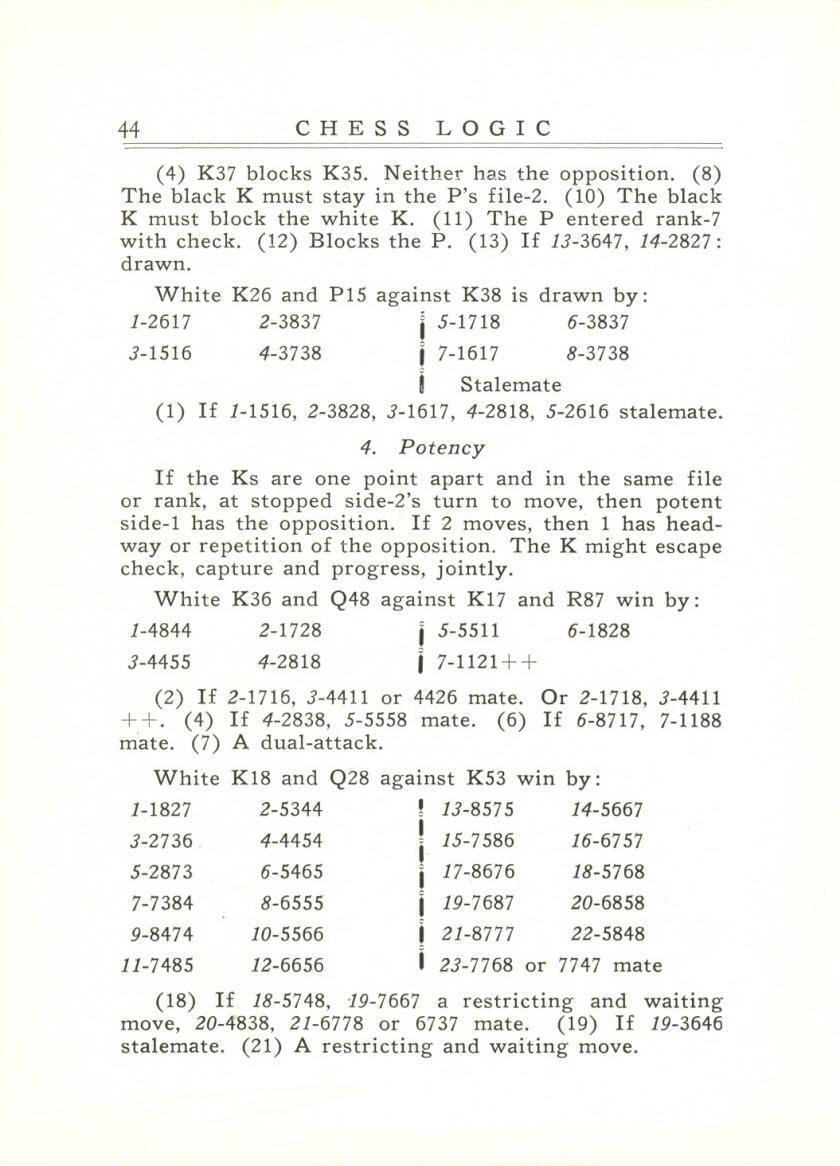
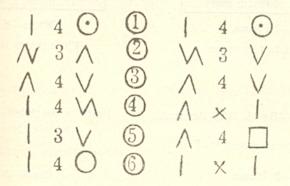
This image in C.N. 4538 was deciphered by many readers. It shows the first six moves of an Evans Gambit game in the Prince Notation, which was described on pages 162-163 of the July-August 1918 American Chess Bulletin as ‘still another attempt to construct a universal chess language’. The creator was Lorenzo Prince of Montreal, and the explanation in the Bulletin is reproduced below:
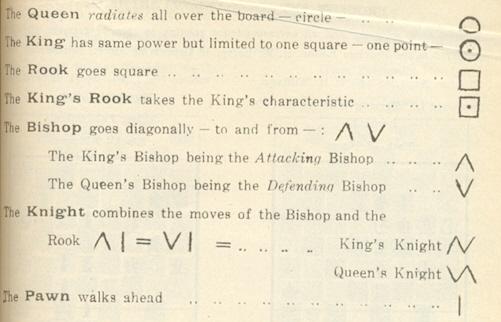
(4546)
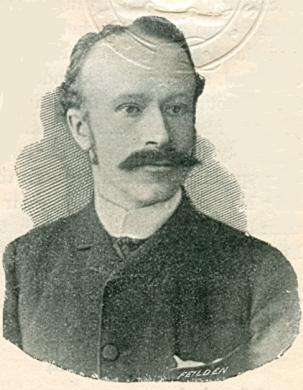
We wonder whether many, or any, readers will recognize this figure, a household name in chess. Culled from page 123 of The Chess Bouquet by F.R. Gittins (London, 1897), the picture is of David Forsyth (1854-1909). Gittins’ book reported:
Usage of the notation was never altogether standardized, and a discussion of the variants on pages 82-83 of the February 1892 BCM included a contribution from Forsyth himself.
(5051)
From page 7 of the 10 February 1883 edition of the Glasgow Weekly Herald we reproduce David Forsyth’s original proposal of the notation named after him:
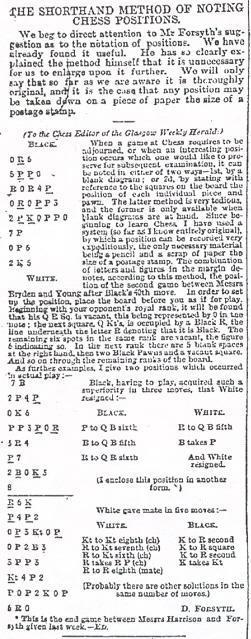
A profile of Miron J. Hazeltine on pages 1-2 of the January 1894 BCM stated:
‘Mr Hazeltine invented “Miron’s Odds”, for beginners beaten too often at the rook. Remove K’s B and Kt, then castle and bid the neophyte, “Come on, Macduff!” etc. He also brought into use the “em dash” (–) for “to” in printing games; also “2d and 3d” for doubled and tripled pawns – both typographical improvements. ...
(5456)
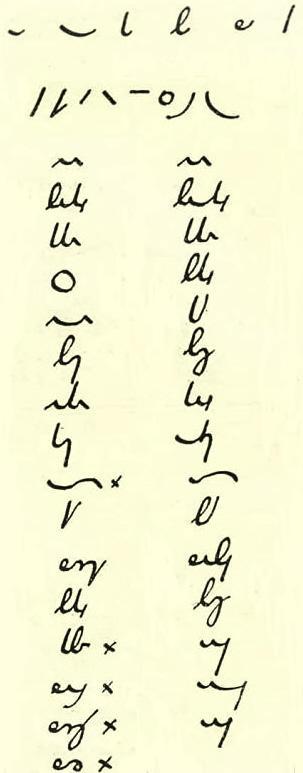
The above illustration depicts a game in shorthand:
1 e4 e5 2 Nf3 Nc6 3 Bc4 Bc5 4 O-O Nf6 5 d4 Bxd4 6 Nxd4 Nxd4 7 f4 Ne6 8 Bxe6 dxe6 9 Qxd8+ Kxd8 10 fxe5 Nxe4 11 Rxf7 Rg8 12 Nc3 Nxc3 13 Bg5+ Ke8 14 Re7+ Kd8 15 Rxg7+ Ke8 16 Rxg8+.
The top line indicates the pieces (king, queen, bishop, knight, rook and pawn respectively), whereas the second line represents the numerals 1-8. We assembled the illustration from an article ‘Chess Shorthand’ by Allen Watkins on pages 263-267 of the August 1916 BCM. (He gave Black’s seventh move, in both descriptive notation and shorthand, as ...B-K3.) A critical reaction, also entitled ‘Chess Shorthand’, by B.G. Laws was published on pages 297-298 of the September issue, and the following month (pages 333-334) Watkins responded.
The general subject had prompted some interest during, especially, the late nineteenth century. For example:
From more recent times (1971) there exists a 12-page mimeographed publication ‘Chess Shorthand’ by Herbert E. Salzer.
(5880)
John Blackstone (Las Vegas, NV, USA) draws attention to an unusual chess notation explained on page 21 of the Evening Post (New York), 10 April 1897:
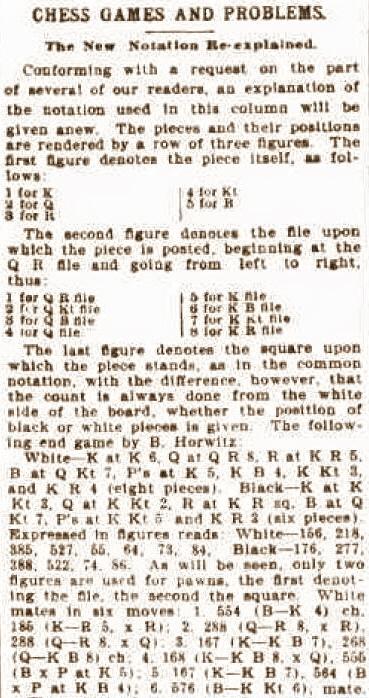
(6834)
A small oddity in the descriptive notation is the omission by old US publications of the digit 1, e.g. R-Q, and not R-Q1. A surprisingly recent book which adopts that practice is The Pleasures of Learning Chess by Fairfield W. Hoban (New York, 1974).
(9028)
It was also still Capablanca’s usage in the handwritten score of his game against Bogoljubow, Moscow, 1925. See Analytical Disaccord (C.N. 8613).
In old chess magazines (English-language ones, in particular), readers’ pertinacity often reached a peak in any ‘discussion’ of the relative merits of the descriptive and algebraic notations. The descriptive notation has now departed (see, for example, Capablanca Goes Algebraic), and an awkward tournure may sometimes result. The opening sentence of The Fox Enigma refers to ‘positions in which a player moved his queen to KKt6 (i.e. g6 or g3)’.
The text of C.N. 71 (‘The leisurely fianchetto’) provides another example:
What is the longest gap in master play between a g- or b- pawn being advanced and the subsequent placing of a bishop on one of the ‘knight two’ squares?
In C.N. 98 W.H. Cozens (Ilminster, England) remarked on the comparative merits of the two notations in such an instance:
1. (Descriptive): What is the longest gap in master play between P-Kt3 and the subsequent B-Kt2?
2. (Algebraic): What is the longest gap in master play between the playing of b3, b6, g3 or g6 and the subsequent Bb2, Bb7, Bg2 or Bg7, as the case may be?
Mr Cozens concluded:
‘Algebraic, for some purposes, can be downright silly.’
Regarding possible difficulties with the descriptive notation, below is a position on page 17 of Test Tube Chess by A.J. Roycroft (London, 1972):
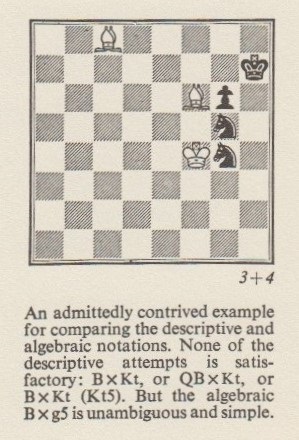
(9650)
Difficulties with the algebraic notation are also shown in Pet Moves in Chess.
On page 69 of Instant Chess by David Levy and Kevin O’Connell (Oxford, 1984) the algebraic notation destroys the alleged Anderssen quote, given as follows: ‘Once get a knight firmly posted at e6 (White) or e3 (as Black) and you can go to sleep. Your game will then play itself.’ Normally ‘K5’ is the square in question.
Another case is the remark attributed to Bent Larsen to the effect that with a knight on KB1 a player who has castled on the king’s side is safe from a mating attack. What exactly did Larsen say or write?
(12112)
Ronald Young (Bronx, NY, USA) draws attention to Larsen’s notes, in algebraic notation, on his victory as Black over Karpov at Montreal, 1979 on pages 452-453 of Chess Life & Review, August 1979:
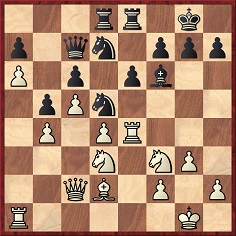
Position after 21 Re1-e4
Larsen played 21...Nf8 and wrote on page 453:
‘So that I do not get mated. With a knight on f8 you never get mated.’
(12186)
Easy Guide to the Game of Chess by Charles Check (London, 1818) used the algebraic notation, as explained on pages 7-8:
‘In order to be easily understood, and indicate clearly the places of the men and their moves, we shall distinguish the square on the same principle on which places are found in geography by their latitude and longitude. When the board is placed between the two players, there are eight rows of squares proceeding from one to the other. These, answering to the ranks of an army, we shall call A, B, C, D, E, F, G, H. These again form eight rows in the cross direction, or files, which we shall mark 1, 2, 3, 4, 5, 6, 7, 8. Thus any square on the board may readily be pointed out.’
A footnote on page 8 began:
‘The method above given is much more convenient for the learner than the usual mode of indicating the squares by the pieces that occupy them at the commencement for those on the line next each player; and for the rest their numeral position in front of these pieces as far as the middle of the board.’
The book was not well regarded by Howard Staunton, who wrote on page 323 of the Illustrated London News, 22 May 1847:

We lack information about Charles Check, notwithstanding an enquiry by H. Maxwell Prideaux on pages 324-325 of the November 1918 BCM:
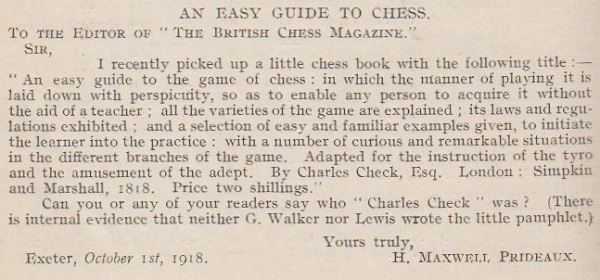
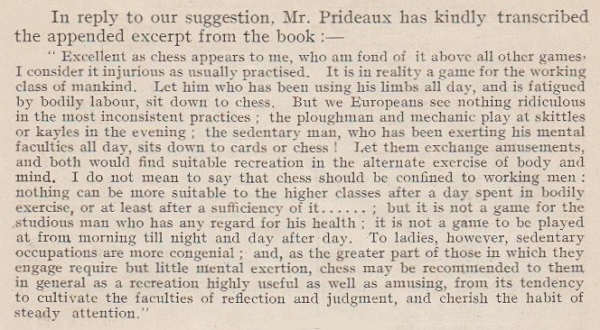
(9653)
From page 58 of NY Chess Since 1972 by Peter Julius Sloan (New York, 2012):

(9659)
From page 49 of the Chess Amateur, November 1907:
‘The “German” Notation. Should the happy time come when chessplayers throughout the world agree to adopt one system of notation, that system will be the one which originated in Germany, and is now used in Prussia, Austria, Italy, Argentine Republic and Holland.’
From page 125 of the Chess Amateur, February 1915 (as quoted in C.N. 4503):
‘We consider the English method perfectly satisfactory and by far the best that has ever been devised. This method may be termed the “Descriptive”. It is in use throughout the British Empire, the United States of America, Belgium and Argentina, and possibly some other countries. The only rival notation is the German method, which for stupidity and clumsiness would be difficult to beat.’
(10703)
On pages 221-222 of La Régence, July 1851 Kieseritzky gave the Immortal Game:
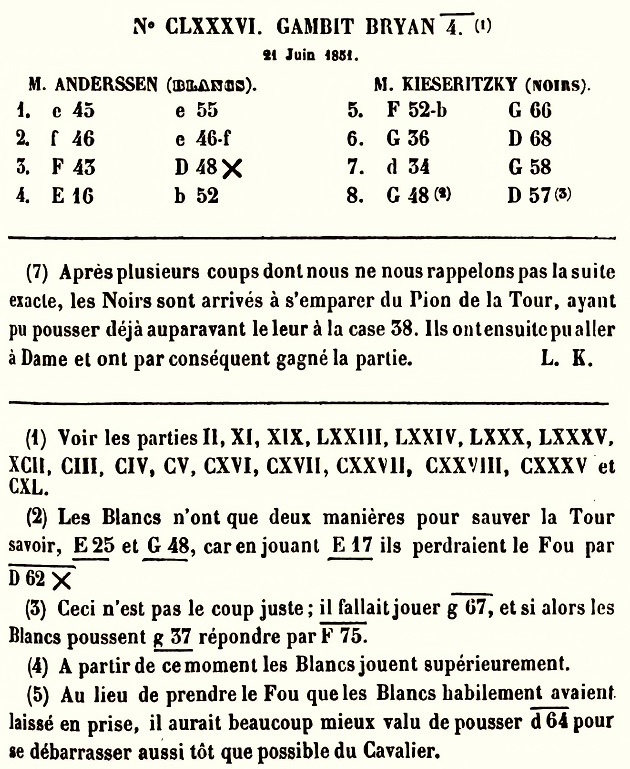
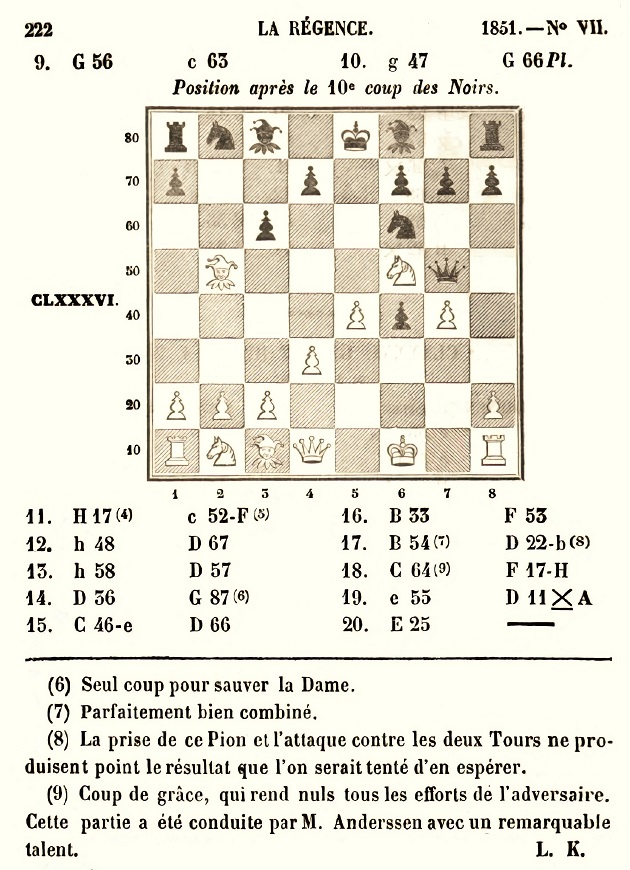
Note 7 on page 221 relates to a previous game in the magazine.
(11381)
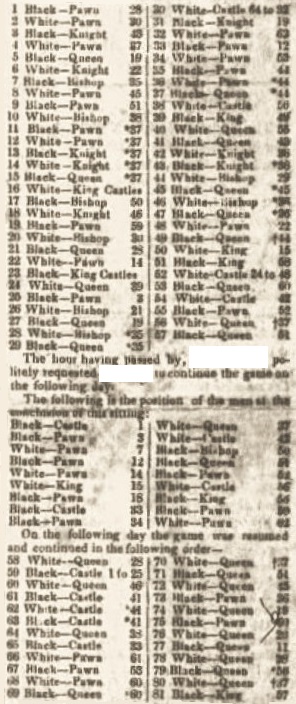
The quiz question in C.N. 11147 about a connection between the above game and a world chess champion was inspired by a contribution from Ian Tregillis (Santa Fe, NM, USA), who forwarded page 1 of the United States Gazette (Philadelphia), 30 January 1827 (a column by ‘Kuthar’):
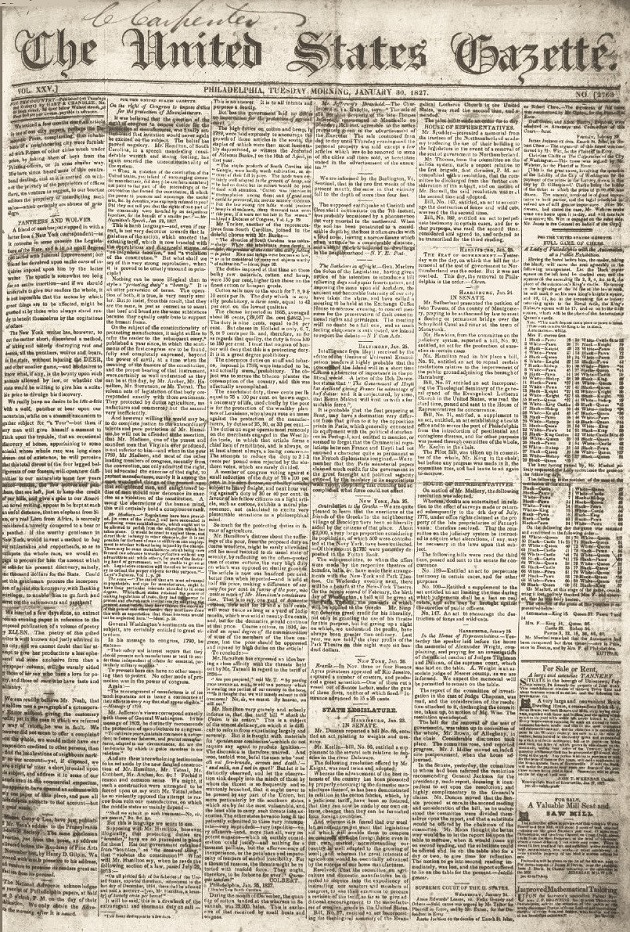

1 e4 e6 2 Nc3 d5 3 Qf3 Nf6 4 Bd3 c5 5 b3 Bd6 6 exd5 exd5 7 Nxd5 Nxd5 8 Qxd5 O-O 9 Bb2 Nc6 10 a3 Be6 11 Qe4 g6 12 O-O-O Qd7 13 h3 Bf5 14 Qf3 Bxd3 15 Qxd3 Rae8 16 Nf3 a6 17 g4 b5 18 c4 bxc4 19 Qxc4 Rb8 20 Kb1 Qb7 21 Qc3 Nd4 22 Nxd4 Be5 23 Qxc5 Bxd4 24 Qxd4 f6 25 Qc4+ Kg7 26 Ka2 Rfc8 27 Qa4 Rc2 28 b4 Qd5+ 29 Qb3 Qe4 30 Rhe1 Qc6 31 Rc1 Rxc1 32 Rxc1 Qd6 33 Rd1 a5 34 b5 a4 35 Qxa4 Qd5+ 36 Qb3 Qc5 37 d4 Qg5 38 a4 Qf4 39 Qg3 Qe4 40 Qxb8 Qd5+ 41 Ka1 Resigns.
The notation to the game, in which Black played first, is unusual, the squares being counted vertically: h1 = 1; h8 = 8; a1 = 57; a8 = 64.
The same configuration was shown differently on page 96 of Chess: Man vs Machine by Bradley Ewart (London, 1980):
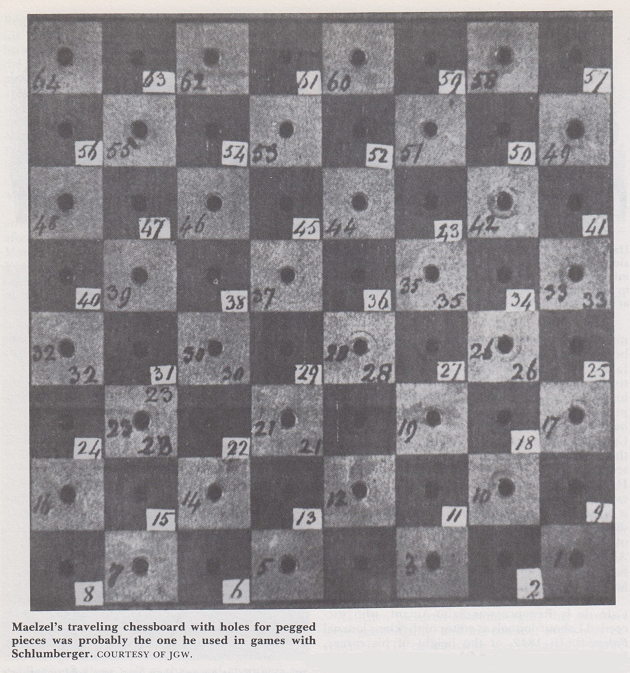
Ewart gave the game, concluding with 38 a4 Qf4 39 Qg3 Resigns, on page 106, dating it 30-31 January 1827.
From page 76 of The Turk, Chess Automaton by Gerald M. Levitt (Jefferson, 2000):
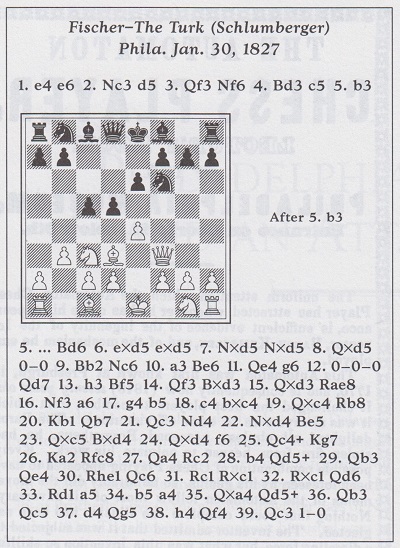
The transcriptions 38 h4 and 39 Qc3 are incorrect. Although Levitt stated that the game was played on 30 January 1827, that is the very date of publication in the Gazette, which, moreover, specified that it was played over two days.
Some information about the winner is on pages 76 and 86 of the Levitt book.
The game was also published, up to 39 Qg3 and with annotations, on pages 57-59 of the American Chess Magazine, 1847 (‘Played many years ago at Philadelphia, and won by a Lady of the celebrated Automaton Chess Player’). See too pages 446 and 464 of the New York, 1857 tournament book (‘Mrs Fisher’). The Fischer/Fisher discrepancy has yet to be clarified.
The best response to C.N. 11747 came from Eduardo Bauzá Mercére (New York, NY, USA), who added that the column about the defeat of the Turk/Schlumberger was reproduced shortly afterwards (exact date unavailable) in the New York Spectator, duly credited to the Philadelphia Gazette:

(11759)
Addition on 2 February 2022:
Eduardo Bauzá Mercére notes that in the Philadelphia Daily Evening Bulletin of 28 January 1865, Gustavus Reichhelm stated that the lady playing the Automaton was Mrs Redwood Fisher (1782-1856).
Regarding a proposal for a new notation from Emanuel Lasker, see C.N. 1221 (pages 125-126 of Chess Explorations). The report had appeared on page 18 of the January 1901 BCM.
An extract from an article ‘International chess by means of Esperanto’ on pages 12-13 of the January 1904 BCM:
‘For correspondence chess, problem tourneys, continental chess tours, or for participation in foreign tournaments, Esperanto is very useful. The articles in Lingvo Internacia translate into Esperanto some 200 chess terms, explaining them in Esperanto by means of examples. The names of the pieces in the new language are: reĝo (K), damo (Q), kuriero (B), ĉevalo (Kt), soldato (P) – names which appeal to thousands of Europeans. [The BCM article omitted the Esperanto for rook: turo.] The word “check” is ŝak (pronounced “shahk”); ŝako, a check; ŝaki, to check; ŝakado, perpetual check, etc. The chess vocabulary of Esperanto contains some very picturesque words. The original sense of the word “mate” has been reverted to, and is translated by mort [sic] (dead), thus renewing the time-honoured phrase “The king is dead”; castling becomes “the king’s leap” (reĝsalto); and stalemate is rendered by neirebleco [sic], meaning “inability to move”. The system of notation is the English, altered only so far as necessary. The commencing moves of a King’s Bishop’s Gambit might be 1 S-R4 S-R4 2 S-RK4 S kaptas (or x) S3 K-K4 S-D4 4 KxS D-T5 (ŝ) 5 R-K1, etc. Problemists are not forgotten and the principal specialities of their vocabulary are dealt with. The articles conclude with the Esperanto version of a celebrated game between Labourdonnais and McDonnell, and a couple of problems. The latter, on account of typographical difficulties, appear in the Forsyth notation, which is recommended and explained. As a result of these articles, correspondence games are now in progress between players of different nationalities.
See Chess and Esperanto.
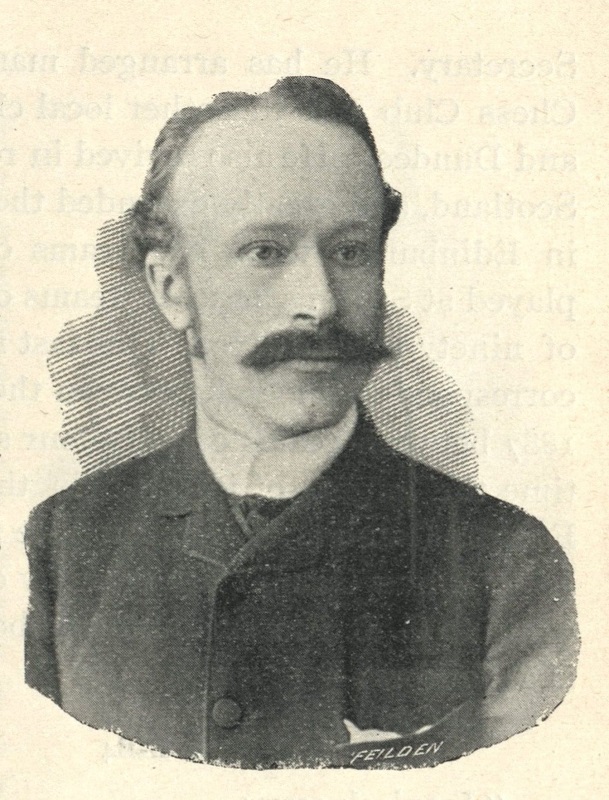
This picture of David Forsyth (1854-1909) was shown in C.N. 5051 from page 123 of The Chess Bouquet by F.R. Gittins (London, 1897). The full entry is below, courtesy of the Cleveland Public Library:
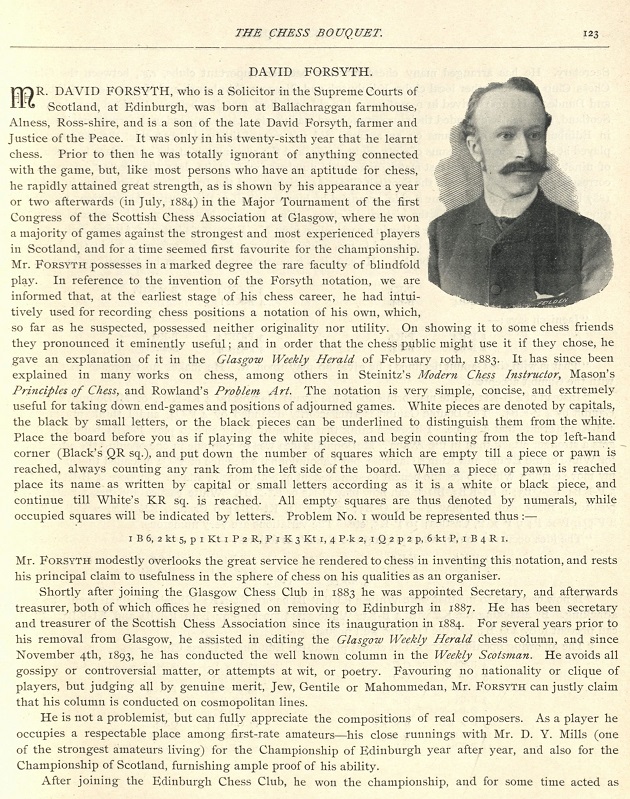
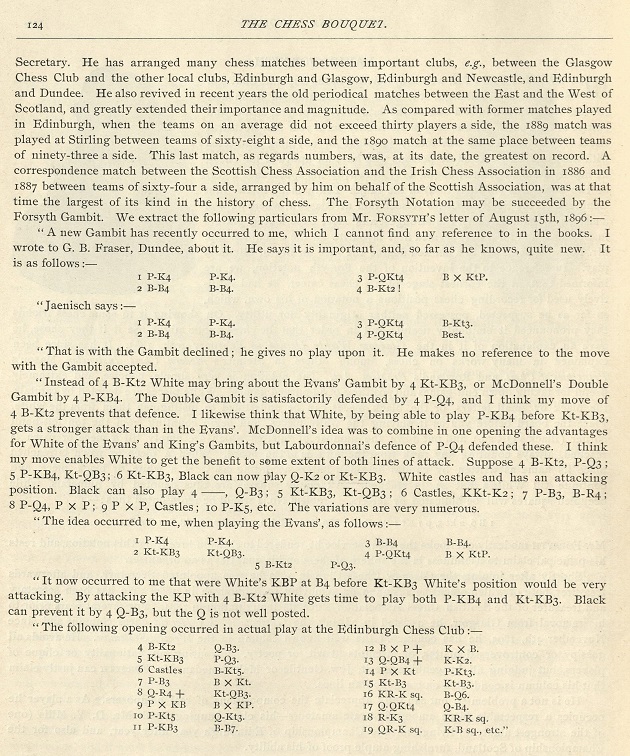
(11884)
Avital Pilpel (Haifa, Israel) writes:
‘Your recent feature article on chess notation prompts me to add some curiosities regarding texts in Hebrew. The revival of Hebrew in chess faced two problems. The first was the establishment of chess terms and whether to follow the continental or English terms, e.g. whether to speak of a malka (queen) or a gvira (dame), or a chayal (soldier, i.e., pawn), ragli (foot soldier), ikar (Bauer), etc. Generally, the English terms prevailed, with one exception: the diagonally-moving piece was, from the outset, called a ratz, runner (i.e. Läufer).
The second issue is more interesting. It seems that the descriptive notation was never used in Hebrew chess literature, which left the problem of how to translate the names of the squares in algebraic notation. The ranks, being numerical, presented no problem, but how should the files be named in Hebrew, a language written from right to left?
The most natural way would be to name the a-file the aleph (the first letter of the Hebrew alphabet) file, the b-file the bet (second letter) file, etc. Strange to say, this was not attempted until Shaul Hon did so in his short-lived chess magazine in 1946. The reason, Hon notes, is that it requires the order of the files to go the “wrong” way, from left to right. An attempt was made to name the files from right to left, aleph denoting the h-file, beth the g-file, etc., as noted on a Jewish Chess History page. Confusingly, this made the notation look like a mirror-image (the Ruy López opening seemed to be 1 d4 d5 2 Nc3 Nf6 3 Bg5), and it was abandoned almost immediately.
Thus until 1946, a curious hybrid existed: chess notation used the Hebrew names – or, rather, initials – for the pieces but the non-Hebrew names for the squares. This gave rise to a further question: in which direction should the text be written? Both possibilities have been tried: right to left and left to right.’
(11885)
Addition on 4 July 2023:
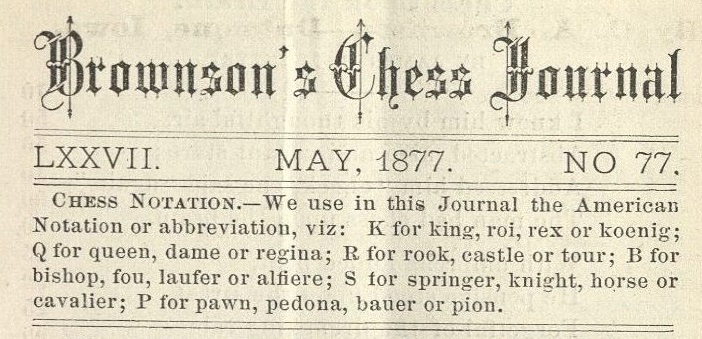
For further information about the magazine see our feature article on Horatio Bolton.
Another relevant feature article is Chess Punctuation.
To the Chess Notes main page.
To the Archives for other feature articles.
Copyright: Edward Winter. All rights reserved.